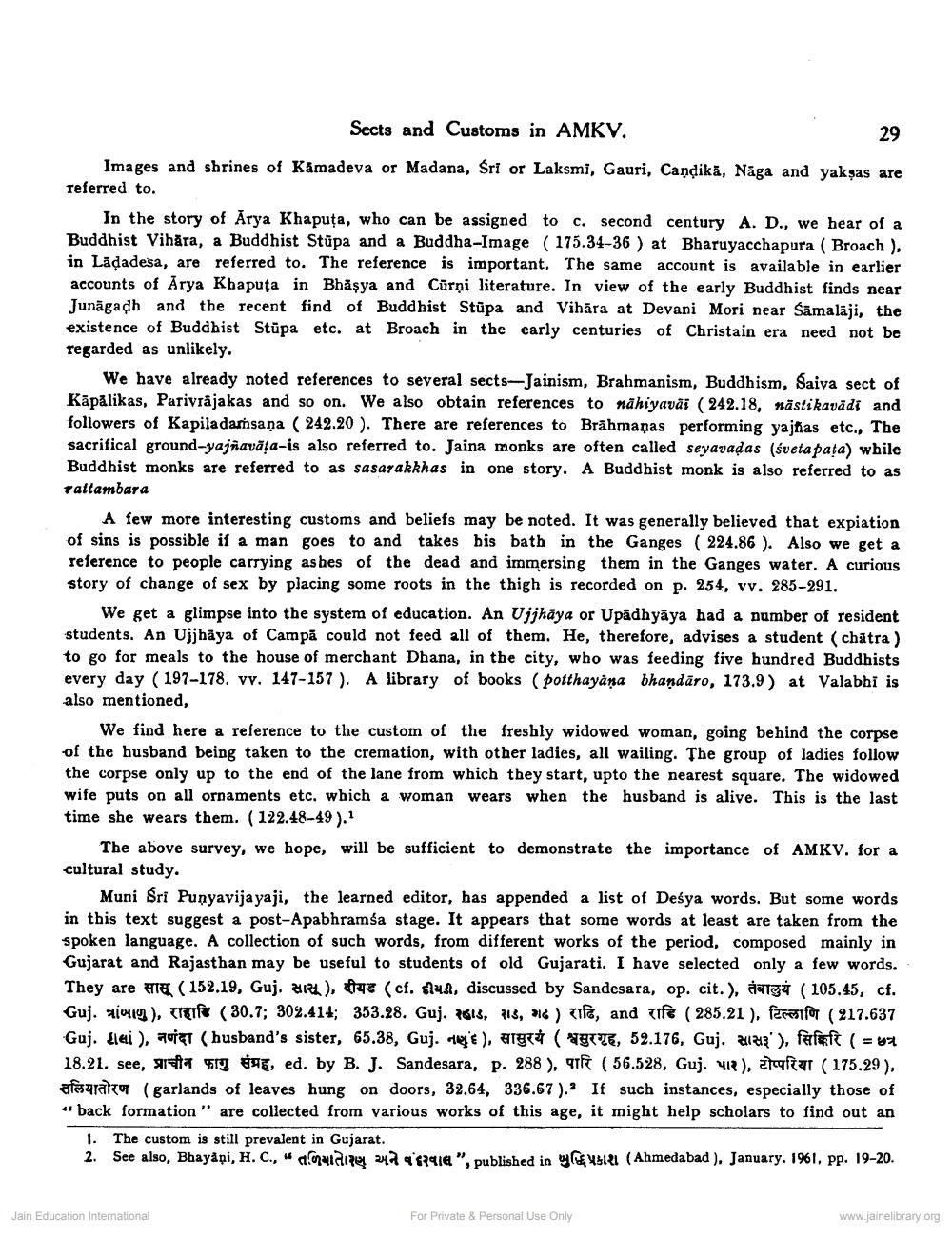________________
Sects and Customs in AMKV,
29
Images and shrines of Kamadeva or Madana, Śri or Laksmi, Gauri, Candika, Naga and yakṣas are referred to.
In the story of Arya Khaputa, who can be assigned to c. second century A. D., we hear of a Buddhist Vihara, a Buddhist Stupa and a Buddha-Image (175.34-36) at Bharuyacchapura ( Broach), in Läḍadesa, are referred to. The reference is important. The same account is available in earlier accounts of Arya Khaputa in Bhasya and Curņi literature. In view of the early Buddhist finds near Junagadh and the recent find of Buddhist Stupa and Vihara at Devani Mori near Samalāji, the existence of Buddhist Stupa etc. at Broach in the early centuries of Christain era need not be regarded as unlikely.
We have already noted references to several sects-Jainism, Brahmanism, Buddhism, Saiva sect of Kāpālikas, Parivrajakas and so on. We also obtain references to nahiyavai (242.18, nästikavādi and followers of Kapiladamsana (242.20). There are references to Brahmanas performing yajñas etc., The sacrifical ground-yajñavăța-is also referred to. Jaina monks are often called seyavadas (svetapata) while Buddhist monks are referred to as sasarakkhas in one story. A Buddhist monk is also referred to as rattambara
A few more interesting customs and beliefs may be noted. It was generally believed that expiation of sins is possible if a man goes to and takes his bath in the Ganges (224.86). Also we get a reference to people carrying ashes of the dead and immersing them in the Ganges water. A curious story of change of sex by placing some roots in the thigh is recorded on p. 254, vv. 285-291.
We get a glimpse into the system of education. An Ujjhaya or Upadhyaya had a number of resident students. An Ujjhaya of Campă could not feed all of them. He, therefore, advises a student (chatra) to go for meals to the house of merchant Dhana, in the city, who was feeding five hundred Buddhists every day (197-178. vv. 147-157). A library of books (potthayana bhandaro, 173.9) at Valabhi is also mentioned,
We find here a reference to the custom of the freshly widowed woman, going behind the corpse of the husband being taken to the cremation, with other ladies, all wailing. The group of ladies follow the corpse only up to the end of the lane from which they start, upto the nearest square. The widowed wife puts on all ornaments etc. which a woman wears when the husband is alive. This is the last time she wears them. (122.48-49).1
The above survey, we hope, will be sufficient to demonstrate the importance of AMKV. for a cultural study.
Muni Śri Punyavijayaji, the learned editor, has appended a list of Desya words. But some words in this text suggest a post-Apabhramsa stage. It appears that some words at least are taken from the spoken language. A collection of such words, from different works of the period, composed mainly in Gujarat and Rajasthan may be useful to students of old Gujarati. I have selected only a few words. They are (152.19, Guj. ), (cf. dua, discussed by Sandesara, op. cit.), (105.45, cf. Guj.), (30.7; 302.414; 353.28. Guj. 14, 15, 16), and ife (285.21), for (217.637 Gaj. Lei), (husband's sister, 65.38, Guj. 't), arged (ager, 52.176, Guj. a), firfeft (=w9?{ 18.21. see,, ed. by B. J. Sandesara, p. 288), 9 afra (garlands of leaves hung on doors, 32.64, 336.67). "back formation" are collected from various works of this age,
(56.528, Guj. e), haftar (175.29), If such instances, especially those of it might help scholars to find out an
1. The custom is still prevalent in Gujarat.
2. See also, Bhayani, H. C., "", published in 1 (Ahmedabad), January. 1961, pp. 19-20.
Jain Education International
For Private & Personal Use Only
www.jainelibrary.org




